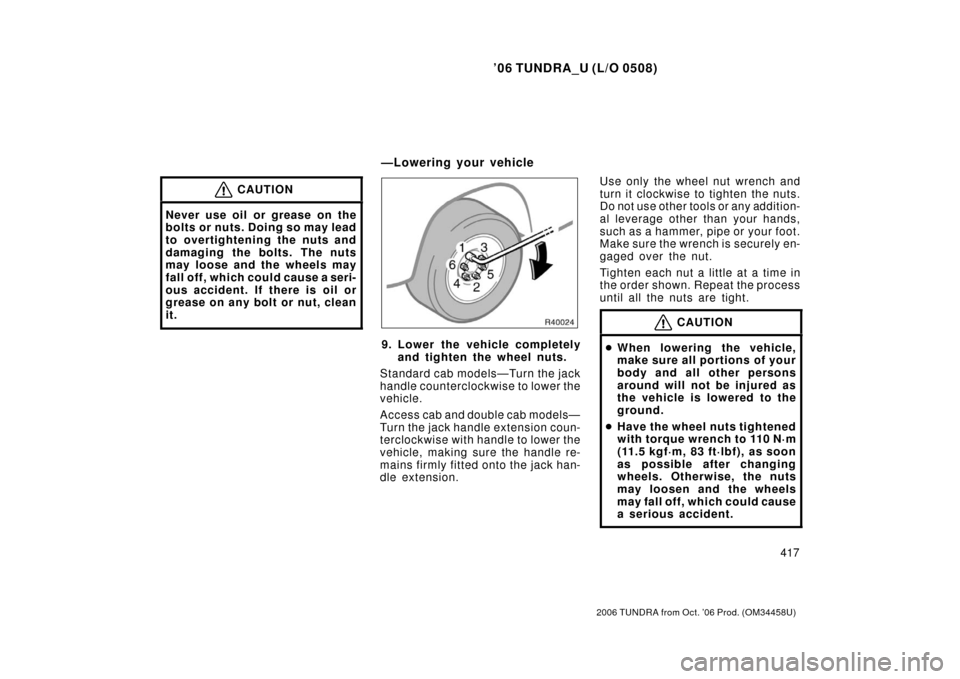Page 408 of 527

’06 TUNDRA_U (L/O 0508)
396
2006 TUNDRA from Oct. ’06 Prod. (OM 34458U)
TOWING CONNECTOR FOR TRAILER
LIGHTS
�Your vehicle is equipped with a wire
harness stored in the rear end under
body. Some models are fitted with a
socket for trailer lights under the rear
bumper. Use either of them to connect
and operate the trailer lights. However,
the trailer lights must comply with fed-
eral, state/provincial and local regula-
tions. See your local recreational ve-
hicle dealer or rental agency for the
correct type of wiring and relays for
your trailer. Check for correct operation
of the turn signals and stop lights each
time you hitch up. Direct splicing may
damage your vehicle’s electrical system
and cause a malfunction of your lights.
7−pin connector (with towing pack-
age)—This can be also connected to
the trailer brake and trailer sub battery. BREAK�IN SCHEDULE
�Toyota recommends that you do not
tow a trailer with a new vehicle or a
vehicle with any new power train com-
ponent (engine, transmission, differen-
tial, wheel bearings, etc.) for the first
800 km (500 miles) of driving.
MAINTENANCE
�If you tow a trailer, your vehicle will
require more frequent maintenance due
to the additional load. For this informa-
tion, please refer to the scheduled
maintenance information in the “Sched-
uled Maintenance Guide” or “Owner ’s
Manual Supplement”.
�Retighten all fixing bolts of the towing
ball and bracket after approximately
1000 km (600 miles) of trailer driving.
PRE�TOWING SAFETY CHECK
�Check that your vehicle remains level
when a loaded or unloaded trailer is
hitched. Do not drive if the vehicle has
an abnormal nose −up or nose −down
condition, and check for improper
tongue load, overload, worn suspension
or other possible causes.
�Make sure the trailer cargo is securely
loaded so that it cannot shift.
�Check that your rear view mirrors con-
form to any applicable federal, state/
provincial or local regulations. If not,
install the rear view mirrors required
for towing purposes.
TRAILER TOWING TIPS
When towing a trailer, your vehicle will
handle differently than when not tow-
ing. The three main causes of vehicle�
trailer accidents are driver error, exces-
sive speed and improper trailer loading.
Keep these in mind when towing:
�Before starting out, check operation of
the lights and all vehicle −trailer connec-
tions. After driving a short distance,
stop and recheck the lights and con-
nections. Before actually towing a trail-
er, practice turning, stopping and back-
ing with a trailer in an area away from
traffic until you learn the feel.
Page 426 of 527
’06 TUNDRA_U (L/O 0508)
414
2006 TUNDRA from Oct. ’06 Prod. (OM 34458U)
CAUTION
Never use oil or grease on the
bolts or nuts. The nuts may loose
and the wheels may fall off,
which could cause a serious ac-
cident.
Front Rear
5. Position the jack at the correct jack point as shown.
Make sure the jack is positioned on
a level and solid place.
JACK POINTS: Front—Under the frame side rail
Rear—Under the rear axle housing
Access and double cab models—Put
a jack handle, jack handle extension
and jack handle end together as
shown in the illustration.
1 Jack handle end
2 Jack handle extension
3Jack handle
CAUTION
Make sure they are each securely
fixed with screws.
—Positioning the jack
Page 428 of 527
’06 TUNDRA_U (L/O 0508)
416
2006 TUNDRA from Oct. ’06 Prod. (OM 34458U)
7. Remove the wheel nuts and
change tires.
Lift the flat tire straight off and put it
aside.
Roll the spare wheel into position and
align the holes in the wheel with the
bolts. Then lift up the wheel and get
at least the top bolt started through
its hole. Wiggle the tire and press it
back over the other bolts.Before putting on wheels, remove any
corrosion on the mounting surfaces
with a wire brush or such. Installation
of wheels without good metal− to−met-
al contact at the mounting surface can
cause wheel nuts to loosen and
eventually cause a wheel to come off
while driving.8. Reinstall all the wheel nuts fin- ger tight.
Reinstall the wheel nuts (tapered end
inward) and tighten them as much as
you can by hand. Press back on the
tire back and see if you can tighten
them more.
—Changing wheels —Reinstalling wheel nuts
Page 429 of 527

’06 TUNDRA_U (L/O 0508)
417
2006 TUNDRA from Oct. ’06 Prod. (OM 34458U)
CAUTION
Never use oil or grease on the
bolts or nuts. Doing so may lead
to overtightening the nuts and
damaging the bolts. The nuts
may loose and the wheels may
fall off, which could cause a seri-
ous accident. If there is oil or
grease on any bolt or nut, clean
it.
9. Lower the vehicle completely
and tighten the wheel nuts.
Standard cab models—Turn the jack
handle counterclockwise to lower the
vehicle.
Access cab and double cab models—
Turn the jack handle extension coun-
terclockwise with handle to lower the
vehicle, making sure the handle re-
mains firmly fitted onto the jack han-
dle extension. Use only the wheel nut wrench and
turn it clockwise to tighten the nuts.
Do not use other tools or any addition-
al leverage other than your hands,
such as a hammer, pipe or your foot.
Make sure the wrench is securely en-
gaged over the nut.
Tighten each nut a little at a time in
the order shown. Repeat the process
until all the nuts are tight.
CAUTION
�
When lowering the vehicle,
make sure all portions of your
body and all other persons
around will not be injured as
the vehicle is lowered to the
ground.
� Have the wheel nuts tightened
with torque wrench to 110 N·m
(11.5 kgf·m, 83 ft·lbf), as soon
as possible after changing
wheels. Otherwise, the nuts
may loosen and the wheels
may fall off, which could cause
a serious accident.
—Lowering your vehicle